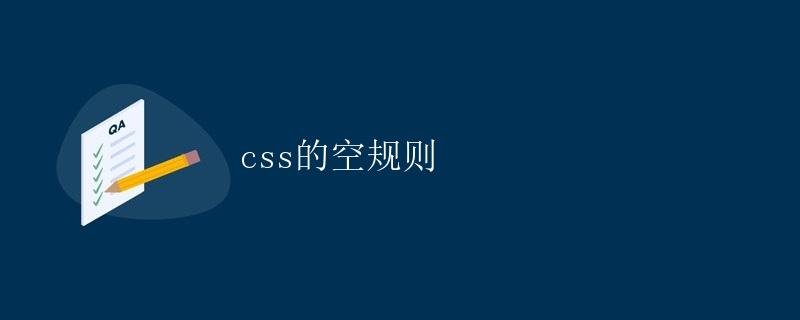Empty CSS rules
CSS Empty Rule

In CSS, an empty rule refers to a rule in a CSS style sheet that does not define any styles. When developing a web page, you may need to set an empty rule for an element. This article will detail the purpose, usage, and practical application scenarios of the CSS empty rule.
The Purpose of the Empty Rule
Although the empty rule does not define any specific styles, it does have unique uses in real-world development. It mainly includes the following points:
- Placeholder: Empty rules can be used as placeholders. For styles that require delayed loading or are dynamically generated, you can define an empty rule first so that you can override them later.
-
Improve Code Readability: When adding comments to a stylesheet, you can use empty rules to mark them and more clearly distinguish between different sections of style definitions.
-
Avoid Style Conflicts: Sometimes you may need to set an empty rule for an element to avoid conflicts with other styles.
Using Empty Rules
In CSS, empty rules are very simple to write. Simply write a selector, without any style definitions. For example:
.my-element {
/* Empty rule */
}
Actual Application Scenarios
1. Placeholder
In actual development, we often need to dynamically add styles to an element or delay the loading of styles. In these cases, you can use an empty rule as a placeholder: define an empty rule first and then dynamically add styles later. For example, let’s say we have a button element that needs to change its background color on hover and also requires lazy loading:
.btn {
/* Empty rule */
}
.btn:hover {
background-color: #f00;
}
2. Improve Code Readability
When adding comments in a CSS stylesheet, you can use empty rules to mark them and more clearly distinguish different sections of the style definition. For example, we can add empty rules before and after comments to distinguish the style definitions of different modules:
/* Title style */
.title {
font-size: 24px;
}
.title2 {
font-size: 20px;
}
/* Empty rule */
.section {
/* Empty rule */
}
/* Paragraph style */
.paragraph {
line-height: 1.5;
}
3. Avoiding Style Conflicts
Sometimes we may need to set an empty rule for an element to avoid conflicts with other styles. For example, if we have a global style sheet and a page-specific style sheet, to prevent the global style sheet from affecting the page-specific style, we can use an empty rule to isolate it:
/* Global style */
.my-element {
font-size: 16px;
}
/* Page-specific style */
.page .my-element {
/* Empty rule */
}
.page .my-element {
font-size: 20px;
}
Through the three practical application examples above, we can see the flexible application and important role of empty rules in CSS style sheets. In real-world development, the appropriate use of empty rules can improve code maintainability and clarity, avoid style conflicts, and achieve more flexible style control.
Conclusion
In CSS, although empty rules do not define actual styles, they play an important role. Through this article, I believe readers have understood the role, usage, and practical application scenarios of CSS empty rules. In actual development, the appropriate use of empty rules can improve code readability, reduce style conflicts, and achieve more flexible style control.